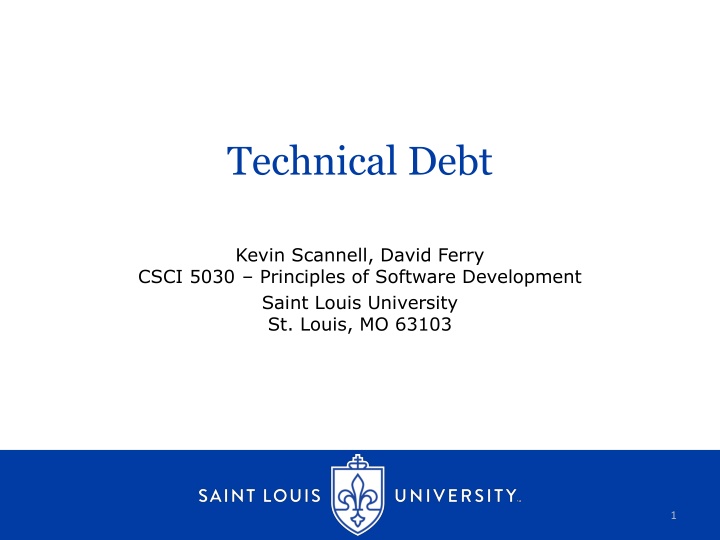
Managing Technical Debt in Software Development
Learn about technical debt in software development, including intentional and unintentional types of debt, their consequences, and strategies for dealing with them. Discover how addressing technical debt is crucial for successful software projects to avoid issues like inefficiencies, bugs, and frustrated developers.
Download Presentation

Please find below an Image/Link to download the presentation.
The content on the website is provided AS IS for your information and personal use only. It may not be sold, licensed, or shared on other websites without obtaining consent from the author. If you encounter any issues during the download, it is possible that the publisher has removed the file from their server.
You are allowed to download the files provided on this website for personal or commercial use, subject to the condition that they are used lawfully. All files are the property of their respective owners.
The content on the website is provided AS IS for your information and personal use only. It may not be sold, licensed, or shared on other websites without obtaining consent from the author.
E N D
Presentation Transcript
Technical Debt Kevin Scannell, David Ferry CSCI 5030 Principles of Software Development Saint Louis University St. Louis, MO 63103 1
Technical Debt Whenever code meets functional requirements but is suboptimal or quick and dirty. E.g.: smelly code inefficient algorithms sloppy design Might be fixed at code-review, might generate TODOs or new issues in the issue tracker Understanding and communicating about technical debt is critical in industry CSCI 5030 Principles of Software Development 2
Debt Analogy Is debt always bad? Real life is about shipping code that works Shipping first time code is like going into debt. A little debt speeds development so long as it is paid back promptly with a rewrite the danger occurs when the debt is not repaid. Every minute spent on not-quite-right code counts as interest on that debt. Ward Cunningham Can you afford to do it without debt? Can you afford the interest? Can you keep the debt and interest manageable? CSCI 5030 Principles of Software Development 3
Strategic, Intentional Debt Cunningham s original definition only considered intentional debt- debt can be planned debt or it can be happened-upon debt, both can be strategic Ship now and deal with the consequences later Examples of intentional or strategic debt: Non-modular design Purposefully too-simple/too-complex implementation Performance indifference Lack of generality or extensibility Lack of scalability CSCI 5030 Principles of Software Development 4
Non-Strategic, Unintentional Debt Debt also accumulates unintentionally, no development process is perfect Examples of unintentional or non-strategic debt: Memory leaks Insufficient test coverage Unintentionally complex implementation Rigid/brittle architecture Performance or scalability bottlenecks Sloppy or difficult to maintain code CSCI 5030 Principles of Software Development 5
Consequences of Debt Too much debt => too much time paying interest Unpredictability in software planning stage, increased risk of investment Slows down future work More bugs, more expensive to fix them Frustrated, unhappy developers CSCI 5030 Principles of Software Development 6
Debt Tradeoff Working Features Technical Debt Debt Value Inflection - Too much time is spent paying interest and development slows to a crawl Time, Size, Lines-of-Code, etc. CSCI 5030 Principles of Software Development 7
Communicating Debt Writing good code isn t just a matter of professionalism or craftsmanship: There is no moral or intellectual imperative to produce good code Every bit of debt incurred today reduces your future ability to produce working features Technical debt has a real cost- not interest as we have described- your future productivity your manager will literally pay for it later Likewise, writing good code or refactoring costs more now, but results in savings later CSCI 5030 Principles of Software Development 8
Debt Avoidance Non-strategic debt is not helpful by definition Avoid non-strategic debt: Use good engineering practices test-driven development, good architectural patterns, etc. If you re not actively working to make your system simpler and with less cruft, it s getting worse Strong definition of done - user requirements are the baseline, how much debt are you willing to accept each sprint or for each feature? Refactoring- reducing debt without changing behavior CSCI 5030 Principles of Software Development 9
Debt Management Known debt is everything recorded in an issue tracker or product backlog Devoting effort to get rid of that debt is a quantifiable business decision Doesn t always make sense to work on debt: e.g. prototypes, end-of-life software, small projects Good practice to pay down debt a little at a time versus ignoring it and making a balloon payment When you find debt- use the boy scout principle : clean up what you can, log the rest as known debt, leave the camp cleaner than you found it CSCI 5030 Principles of Software Development 10
